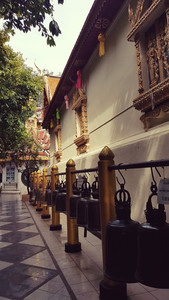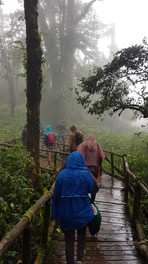If you are planning a vacation to Southeast Asia, be sure to check out the Northern Thailand. If you enjoy exploring highlands and nature where surrounding with floral paradise, secluded forests and waterfalls, misty hiking trail to the summit of this nation, history-telling temples, and palate-stimulating street food cultures, then you will love your stay in Chiang Mai.
This is a perfect sanctuary of sorts, with refreshing combination of city accoutrements and sensibilities of the nature. Chiang Mai is the ancient capital city of Lan Na Kingdom, full of artisans and craftspeople, lush mountains and historic temples, and it has cultivated some of Thailand's best education institutions and agricultural landscape. It creates a disposition that is laid-back, creative and reverential, and that's how this lovely city attracts tens of millions of visitors every year. Here are my top recommendations for your first stay in Chiang Mai.

1. Wat Phra Singh Woramahawihan Temple

Chiang Mai is lauded for its enduring northern Thai and significant cultural heritage. It is also known for its quaint walled quarters filled with temples, and its guardian temple-crowned mountain endowed with mystical attributes. With renowned temple complex and historic sites established over centuries, Chiang Mai is the best hub for a vibrant culture exploration.
The iconic Wat Phra Singh Woramahawihan is the central representation of Chiang Mai's royal temple orchard, and it showcases the traditional Lanna arts and architecture, using teak harvested in the once-dense frontiers and telling its enriched stories and histories inherited from ancient Burma and China.
This temple houses a well-known Buddha image which Thai people regularly come to pay respect to. During important festivals the image in moved outside for public merit-making. Inside of the sanctuary where Phra Singh resides are mural paintings depicting the traditional life of ordinary people. As one of the biggest royal temples in Chiang Mai, it holds many state ceremonies. This should be the starting point of your Chiang Mai Old City walling tour.


2. Wat Chedi Luang & Wat Phantao Temples

Wat Chedi Luang Temple is an historic and venerable temple in Chiang Mai, situates right in the center of Chiang Mai Old City core. This is a renowned temple complex with a partially crumbed 15th century Lanna-style chedi and a pillar that are believed to protect the entire city. This was also one of the tallest structures in ancient Chiang Mai.
The Emerald Buddha is now held in Bangkok's Wat Phra Kaew, and there is a replica made of jade, which was given as a gift from the Thai King in 1995 to celebrate the 600th anniversary of this chedi as well as the 700th anniversary of Chiang Mai city itself. Wat Chedi Luang is close to Wat Phra Singh Woramahawihan, they are a few blocks away from each other.
Near Wat Chedi Luang, there is also the famous Wat Phantao, which is a small-scaled ornate teakwood temple and monastery complex that evokes mist-shrouded forests and the largess of the teak trade. You will see these colored mirror mosaics decorate naga bargeboards, and the facade's primary ornamentation of a peacock over a dog represents the astrological year of birth of the former royal resident.
3. Wat Inthakhin Sadue Temple

Just one block north from the center of Chiang Mai Old City, you will discover a smaller-scaled yet beautifully established Buddhist temple, Wat Inthakhin Sadue, with traditional Lanna architecture, once the site of the sacred city pillar, Inthakhin Pillars. These pillars were moved from Wat Inthakhin to be enshrined at Wat Chedi Luang, along with the restoration of Inthakhin Temple. The temple hosts an important Buddha image that has been in Chiang Mai for a long time. The Buddhist known as Luang Pho Khao, which is a Lanna-style Buddha image. It is filled with kindness, which makes those who worship to be happy and calm.


4. Wat Chiang Man Temple

Another founding member of Chiang Mai's royal temple orchards is Wat Chiang Man, the oldest temple complex in Chiang Mai, was established by the city's founder, Phaya Mengrai, prior to 1300. The temple hosts two famous Buddhas, which resides in the small sanctuary to the right of the main chapel of the temple complex. Phra Sila is a marble bas-relief Buddha that was reportedly came from Sri Lanka or India. Phra Sae Tang Khamani, crystal image, is thought to have come from Lavo 1800 years ago. Wat Chiang Man practically witnessed the entire birth and the history of Chiang Mai and welcomes visitors since the day one.

5. Wat Lok Moli Temple

If you plan to take an evening stroke around the Chiang Mai Old City after a decent dinner, right outside of the north boundary of the quarter, you will find a well-illuminated, majestic-looking Wat Lok Moli Temple. As one of the oldest temples in Chiang Mai, this site features a 14th century chedi, manicured garden and an impressive prayer hall for visitors. The entrance to Wat Lok Moli is guarded by two impressive stone elephants, and you will find lots to see at the temple ground, including interesting limestone statues, Buddha images, Lanna-style architectures and lush garden and plantations. As the temple is not visited as often as other temples and therefore sometimes you might even find yourself alone in the whole temple grounds to fully take in the serenity and laid-back experience.
5. Wat Phra That Doi Suthep Temple

Despite the fact Chiang Mai Old City and its surrounding may offer you the ultimate culture and food experiences, there are just so much more to explore outside of Chiang Mai city. This is one of the best place in Thailand that you can plan and book multiple of your own day-trips, you can book more day-trips for temple and cultural village visiting, you can book day-trips for more walking tours and street food tours, you can even book day-trips for spa and messages, mountain cycling, safari tours, guided hiking, even to attend cooking schools. Options are unlimited and up to your imaginations!
One of the must-to-do day trip is the signature tour of visiting Wat Phra That Doi Suthep, which situates just outside of west Chiang Mai, on the highland, overlooking the city from its mountainous throne. Wat Suthep is probably one of the most scared temples in Northern Thailand. It was established in 1383 under King Keu Naone and has a mystical birth story. A visiting Sukhothai monk instructed the Lanna King to establish a temple with the twin of the miraculous Buddha relic and was mounted on a white elephant, which wandered the mountain until it finally died at this spot to be the chosen location for the temple complex.
There are lots of shrine and prayer halls in the complex, as well as the statue of the white elephant and the Buddhist relic. On the second floor terrace, you will find the picturesque golden chedi that enshrines the relic, and topped with a five-tiered umbrella in honours of Chiang Mai city's independence from Burma and its union with Thailand. This is one of the most iconic and must-have cultural experiences that you can ask for in Northern Thailand.

6. Hmong Village Cultural Museum

After visiting the Wat Phra That Doi Suthep, near the summit of Doi Pui are two famous Hmong Villages. Ban Doi Pui is off the main road and is basically a tourist market at high altitude where you can find lots of handcrafted Hmong-style bags, wallets, clothing as well as personal accessories. A more interesting stop is the Ban Kun Chang Kian, which is just 500m down the dirt track from the Doi Pui campgrounds. The village runs a coffee house that is surrounded by coffee plants that are harvested for sales.
There is a Hmong hill-tribe cultural museum that displays historic culture, people, agriculture and arts related exhibitions. The village is full of lush plantations and tropical floral coverage. It will be a great educational and culture-oriented experience, and it is a perfect day-trip combination along with Wat Phra That Doi Suthep. You can easily book this day-trip online or with travel agencies in Chiang Mai, otherwise you can always rent a bicycle or motorbikes if you are up for some free exploration by yourselves!

7. Doi Inthanon National Park & Hmong Terrace Fields

Another awesome day-trip that you can plan, near Chiang Mai as well, is to visit the Doi Inthanon National Park. This is where the tallest peak of Thailand, Mt. Doi Inthanon, situates, which has a high altitude of over 8,400 ft or above 2,500m above sea level. There are lots of interesting sites included in the day-trip package. One of the most iconic activities to do along the way to the summit is to visit the nearby Hmong village and its agricultural effort of managing rice terraces and harvesting. This is probably one of the best Instagrammable spot in Northern Thailand, and despite of being a heavy touristy site, the guide offers resourceful information about Hmong's hill-tribal cultures and local agricultural businesses.

8. Mt. Doi Inthanon Summit - The Highest Point of Thailand (8,415 ft / 2,565 m)

This is probably one of the things that you can cross off your bucket list items if you make it to the Summit of Mt. Doi Inthanon, the highest peak of Thailand. The mountain ascends from the humid lowlands into the cool cloud belt where moss and ferns thrive. This is well over 8,400 ft. or above 2,500 m above sea level, if you are lucky enough to visit on a raining day, you will be able to experience a rainy yet misty atmosphere on the summit, which adds an additional layer of mystery and sacredness. The air is fresh, clean and cool. The views are spectacular. There's a Royal Project, waterfalls, shops, caves, and lots of other attractions on the mountain and around the base of the mountain waiting for you to explore. The national park is one of the top destinations in Southeast Asia for naturalists and birdwatchers.
9. Phra Mahathat Naphamethanidon & Naphapholphumisiri

On your way to or back from the peal of Doi Inthanon, just about 3km before the summit, set amid lush tropical gardens, the twin stupas of Phra Mahathat Naphamethanidon and Phra Mahathat Naphapholphumisiri were built by the Royal Thai Air Force to commemorate the king’s and queen’s 60th birthdays in 1989 and 1992, respectively. These two are probably the signature of Chiang Mai's modern architectural elegance that attracts millions of visitors to the scared site every year.
This elongated flowerbud shape of the red granite Naphamethanidon chedi is mirrored by the purple granite spire of the Naphapholphumisiri chedi, both constructed in a modernist style that marks them out from other important monuments in Northern Thailand. The two chedi enshrine Buddha images and bas-reliefs of Buddhist scenes offering great views from their terraces that overlook the entire Chiang Mai city and endless Danen Mountain Range.
10. Royal Agricultural Station Inthanon

One of the most important Royal Projects in the Northern Thailand is the Royal Agricultural Station on the half way to Doi Inthanon. This elegant garden and floral complex center not only attracts millions visitors every year, but also it embraces that major effort as one of the top research centers of the Royal Station. It was found un 1977 by the His Majesty King for the purpose to improve Thai tribesmen's life. The royal station has a mission to support local tribes to cultivate and sell more crops, have permanent habitation, stop opium planting and trading which created major historical impact and social implications on local tribe's life. It also serves the purpose of forest protection, shifting cultivation and high-tech oriented soil and water preservation systems to ensure sustainable agricultural efforts.
The Station provides a lot of activities for visitors including agricultural tour (visiting winter vegetable garden, 80th Anniversary garden, flower house, thousand year rose garden), cultural tour (visiting Mong Khun Klang village), and natural tour (Doi Inthanon National Park which is the tallest point of Thailand, Siri Phum Waterfall and Siri Phum Royal Garden, and elaborated Phra Mahathat Naphamethanidon and Phra Mahathat Naphapholphumisiri). This station is included in many day-trip's packages that offer you a holistic natural experience, and you and your family can easily spend a day here exploring different waterfalls nearby.
11. Wachirathan Waterfall

After navigating through the winding mountain path and the lush forest through the Mt. Doi Inthanon, you will stumble upon one of the most majestic, impressive waterfall in Northern Thailand, Wachirathan Waterfall. This waterfall is amongst the most popular waterfalls in Doi Inthanon National park due its immerse scale and accessibility to visitors. It stands 40 meters in height, Wachirathan rushes into the river below, throwing out a thick sheet of mist into the jungle surrounding it. There is a main viewing deck which most visitors stick to, though there is also a short climb up a set of stairs, as well as a path that leads down to the river's edge, both of which offer varying and more photogenic views of the falls with fewer visitors.
Believe me, this waterfall will boost up your Instagram community and vlog impression by a huge inch. This is an absolutely gorgeous scenery that no wonder draws tens of millions of visitors each year to witness its grand view. There are lots of Hmong tribal-style restaurants nearby for a decent lunch while enjoying the picturesque natural monument.

12. Wat Rong Khun - White Temple (Chiang Rai)

Prior to Chiang Mai's prominent status and being the largest city in Northern Thailand, there was another ancient, incredible province adjacent to it - Chiang Rai. As highland mountain ranges each into the conifer zone and unite the kingdom culturally with its neighbors Laos, Myanmar and China, by travelling around this region, it will grant you spectacular sceneries, unique cuisines and glimpses of different cultures and lives beyond the nation's border. You should explore you way further north into the mountainous region, which is best accessed via the culture trail from the ancient capital Sukhothai and its time-worn ruins to the diamond ramparts of Lamphaeng Phet and the teak mansions of Lampang.
Chiang Rai, as Thailand's northernmost province, it contains a dynamic collection of natural sceneries and enriched cultural heritage. The shred border with Laos and Myanmar creates the illusion of multinational journeys, and a variety of hilltribe villages struggling to maintain their cultural identity and traditional lifestyle that can be visited on some ecotour trekking programs that you can have the opportunities to contribute to the local communities while learning about various tribal cultures. As Chiang Rai has so much to offer to visitors, you are strongly recommended to book a separate multi-day trip jus to visit Chiang Rai; however, this particular section of my blog and recommendations only tailor towards a quick day-trip to Chiang Rai from the city of Chiang Mai, which takes you about 3 to 4 hours drive one-way.

If you are going to plan a comprehensive day-trip to Chiang Rai, likely you will set your goal to visit three famous White, Blue and Black temples, scattered around the city of Chiang Rai, and each of them are included in the packages attracting millions of visitors each year. The most signature temple among the three is the Wat Rong Khun, a.k.a. the White Temple.
Whereas most of Thailand's Buddhist temples have centuries of history, the construction of the Wat Rong Khun just began in 1997 by noted Thai painter-turned-architect Charlermchai Kositpipat. Seen from the distance, the temple appears to be made of glittering porcelain, but if you take a closer look, it will reveals that the appearance is due to a combination of whitewash and clear-mirrored chips that incorporated on these temple structures. The white color signifies the purity of the Buddha, while the glass symbolizes the Buddha’s wisdom and the Dhamma, the Buddhist teachings. It is probably one of the most recognizable temples in Thailand, and from my personal perspective, this level of craftsmanship and artistic design totally deserve a spot on my bucket list and I was glad to cross it off with full satisfaction.

13. Wat Rong Suea Ten - Blue Temple (Chiang Rai)

What is better than a modern artistically designed temple complex with well-received public perceptions and reviews is to have another signature temple signed by the talent student (Putha Kabkaew) of the very same Charlermchai Kositpipat! This talented artist invested full effort to design and build Wat Rong Suea Ten, a.k.a. the Blue Temple, from ground up and the project was completed in 2016. This is a Buddhist temple that stands out from the others because of its sapphire blue color, but it is not an active temple, and no monks live here. The temple translates to the "house of the dancing tiger" which was named after the tigers that once roamed the nearby area.
The main building of the Blue Temple is the viharn, the assembly hall, and with huge Naga snakes guard its entrance. The richly adorned gable is in the traditional Lanna style with intricate floral motifs. At the back of the building stands a large white image of the Buddha in subduing Mara or Calling the Earth to witness mudra. This is together with the White Temple and the Black House enjoy as the modern crown jewel of Chiang Rai.

14. Baan Damn Museum - Black House (Chiang Rai)

If Charlermchai Kositpipat describes the theme of his White Temple as the "heaven", then it must be "hell" themed project for the iconic artistic design by the bizarre brainchild of Thai National Artist, Thawan Duchanee, and his very best art representation, the Baan Damn Museum, a.k.a., the Black House. It is a complex of 40 buildings, most made of dark teak wood, set in large, beautiful gardens, and the buildings house a rare collection of paintings, sculptures, silver and gold items, animal bones and skins.
The architecture of the Black House is a mix of Lanna, Laotian and South East Asian styles, both traditional and modern. There is a great variety in styles; a number of the wooden buildings adorned with very intricate carvings are built in the traditional style of Lanna; a few modern structures resemble white igloos. Most of the art works are Lanna, Thai, Burmese and Balinese. Several Thai pieces date back to the Ayutthaya era.
As opposed to the White Temple that pursues the mental status of heaven, serenity, purity and holiness, the primary theme of the Black House is "the darkness of the heart of man". You will also find Buddhism themes like death and rebirth or the reincarnation, ageing and decay. Another theme is suffering caused by human desire, represented by large phalluses in several of the houses. This is one of the ultimate artistic representations that embraces traditional and modern ideologies, religious aspects, and artistic expressions to the fullest in the country.

15. Sunday Walking Street & Night Markets

If you would like to experience the bustling visitor traffics and local vendors' enthusiasm, to enjoy the delicious local street food and vibrant culinary cultures, to catch some traditional music and street performances, and also to get all handcrafted souvenirs for your family and friends on one-go, then these nigh markets are perfect places for you. In fact, you are strongly recommended to check out different night markets on a daily basis during your stay and just simply wandering around will grant you an immersive cultural experience.
Beside the famous Chiang Mai Night Bazaar, Chinatown Night Bazaar, and Kalare Night Bazaar, which all operate on a daily basis, if you stay falls on a weekend, you should check out the Pae Sunday Walking Street.
The Sunday Walking Street Market is held every Sunday from 4pm until about midnight when all the crowds depart. This market draws millions of visitor each year and it is located within the Old City walls, with food stalls and vendors set up 1km along Ratchadamnoen Road, as well as spreading through the side streets, alleyways and Tha Phae Gate. From the late afternoon until the midnight darkness the bustling streets in the Chiang Mai Old City quickly come to life with massive traffic of people and visitors enjoying the evening.
Chiang Mai Sunday Market is the ultimate paradise for foodies, and as one myself, I can fully testify that this statement is totally justified. There are multiple areas just dedicated to food stalls, you can get whatever food you feel like and at amazing prices! From all sorts of fresh tropic fruits, crushed ice drinks and smoothies, local snacks, noodles soups, charcoal grilled seafoods, even a crazy amount of sweets and desserts, like mango and sticky rice. You can have them all here, up to your imagination and waist capacity of your jean, haha!
If you would like to take it easy and are craving typical Thai foods such as pad thai, coconut pancakes and curry, there is an abundance available right on the street everywhere, and with friendly locals serving up decent sized portions you just can't go wrong with it! However, say if you are up to your A-Game, and you are feeling much more adventurous and would like to YOLO it, then you might want to give these fried insects a try. There is a whole variety of alternative protein selections available, from tarantulas, crickets, worms to so many more creepy crawlies if you are brave enough! Chiang Mai might be the right place that makes or breaks you, so challenge cautiously :)
16. Chiang Mai Thai Farm Cooking School

Here I leave the best to the end! There is no way that you can call for a completed vacation and cultural adventure in Chiang Mai without partaking in any cooking school program. What is a better way to absorb different culinary culture beside tasting these delicious foods is to study and replicate these very same dishes so that you can show off to your family and friends back home and get them to accept and enjoy these amazing recipes as well.

One of my favorite cooking classes that I took during my years of travelling adventures is probably here in Chiang Mai, with a one-day culinary program called Chiang Mai Thai Farm Cooking School. You can easily book a tour by checking out the website or ask if any agency carries cooking classes with them. We started off the day with a morning market visit and our teacher showed us around different spices, tropical fruits, local snacks and vegetables.
For the schedule day-trip program, a total of 6 or 7 dishes that you will be taught how to prepare with detailed instructions and you have to select proteins and curries of your preferences. Throughout the day, cooking school will provide you with snacks, lemongrass teas, coffees and beverages for your consumption, and you will be able to enjoy the dishes that you will learn about and prepare. For details of the cooking school program and recipes please refer to my associated Chiang Mai blog on foods.

Not only you and your family can get to connect with other travels and curious foodies from around the world, but also you get to communicate with you teacher and teaching assistants that they assigned to you to ensure a smooth learning journey. At the end of the program, you will get a certificate along with a recipe book with all signature Thai dishes that you can imagine. This is probably the most valuable souvenir that I can ask for of this whole trip, and this is a once-of-a-lifetime experience. I still remember lots of vivid details that I can continue telling these lovely stories of this amazing adventure, and I hope you would have the same experience to share with the world or your loved ones after your visit.
As an avid world traveler, I have been stumbling upon so many amazing places. From tropical exotic paradises to spiritually enriched culture adventures, yet, Chiang Mai always holds a very special place in my heart. This is one of my top vacation destinations that I would visit back all the time and am sure that each visit will lead to a different exciting journey ahead. As an avid foodie and culinary challenger in my social circle, this is one of my top options that I would recommend to all my family members and friends to visit.
There is nothing should stop you loving Chiang Mai! Many digital nomads and expats still prefer to have tropical beaches at Southern Thailand and the bustling lifestyle in Bangkok, yet Chiang Mai's fascinating charisma of people and the inspirational celebration of cultural diversity gradually won over countless visitors and settlers around the world to explore and to make a living in this ancient city. This is something that we should cherish all the time throughout our adventures.
Save me a bowl of Khao Soi, and 'till the next time, Chiang Mai!
TipsyMonkey
Chiang Mai, Thailand. 2018















































































































Comments